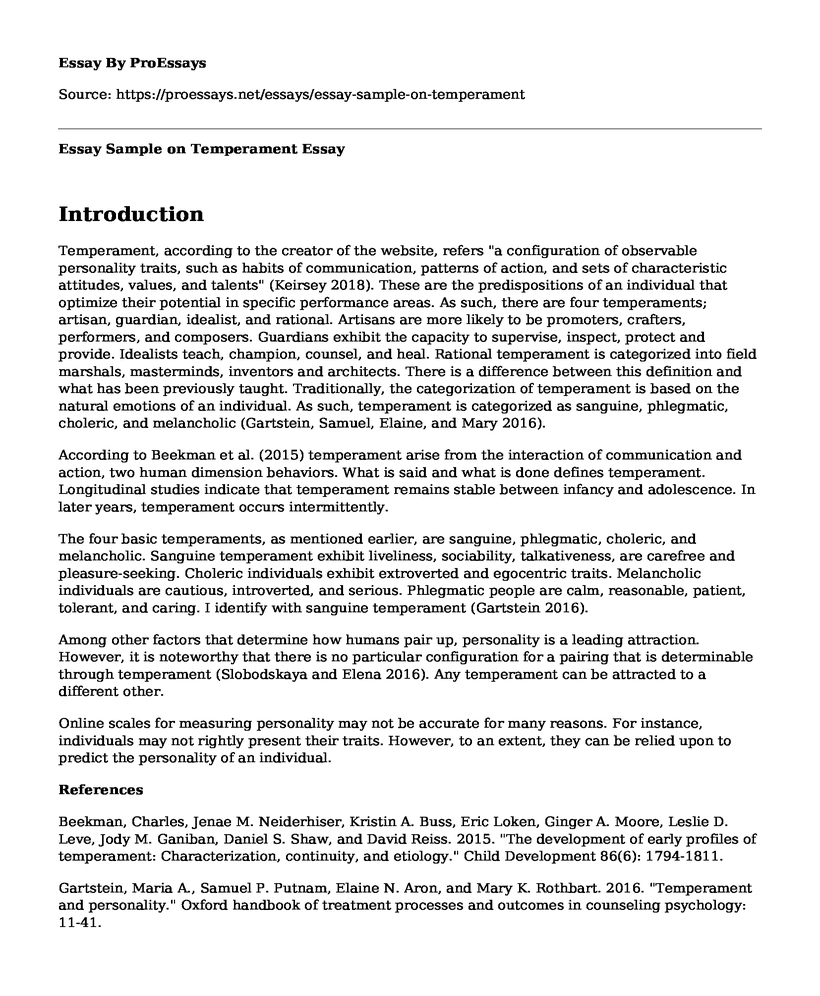Introduction
Temperament, according to the creator of the website, refers "a configuration of observable personality traits, such as habits of communication, patterns of action, and sets of characteristic attitudes, values, and talents" (Keirsey 2018). These are the predispositions of an individual that optimize their potential in specific performance areas. As such, there are four temperaments; artisan, guardian, idealist, and rational. Artisans are more likely to be promoters, crafters, performers, and composers. Guardians exhibit the capacity to supervise, inspect, protect and provide. Idealists teach, champion, counsel, and heal. Rational temperament is categorized into field marshals, masterminds, inventors and architects. There is a difference between this definition and what has been previously taught. Traditionally, the categorization of temperament is based on the natural emotions of an individual. As such, temperament is categorized as sanguine, phlegmatic, choleric, and melancholic (Gartstein, Samuel, Elaine, and Mary 2016).
According to Beekman et al. (2015) temperament arise from the interaction of communication and action, two human dimension behaviors. What is said and what is done defines temperament. Longitudinal studies indicate that temperament remains stable between infancy and adolescence. In later years, temperament occurs intermittently.
The four basic temperaments, as mentioned earlier, are sanguine, phlegmatic, choleric, and melancholic. Sanguine temperament exhibit liveliness, sociability, talkativeness, are carefree and pleasure-seeking. Choleric individuals exhibit extroverted and egocentric traits. Melancholic individuals are cautious, introverted, and serious. Phlegmatic people are calm, reasonable, patient, tolerant, and caring. I identify with sanguine temperament (Gartstein 2016).
Among other factors that determine how humans pair up, personality is a leading attraction. However, it is noteworthy that there is no particular configuration for a pairing that is determinable through temperament (Slobodskaya and Elena 2016). Any temperament can be attracted to a different other.
Online scales for measuring personality may not be accurate for many reasons. For instance, individuals may not rightly present their traits. However, to an extent, they can be relied upon to predict the personality of an individual.
References
Beekman, Charles, Jenae M. Neiderhiser, Kristin A. Buss, Eric Loken, Ginger A. Moore, Leslie D. Leve, Jody M. Ganiban, Daniel S. Shaw, and David Reiss. 2015. "The development of early profiles of temperament: Characterization, continuity, and etiology." Child Development 86(6): 1794-1811.
Gartstein, Maria A., Samuel P. Putnam, Elaine N. Aron, and Mary K. Rothbart. 2016. "Temperament and personality." Oxford handbook of treatment processes and outcomes in counseling psychology: 11-41.
Keirsey. 1998. "Mating and Temperament'. Retrieved December 24, 2018, https://legacy.keirsey.com/couples.aspxKeirsey. 2018. "Keirsey Temperament Assessment." Retrieved December 24, 2018, https://keirsey.com/temperament-overview/.
Slobodskaya, Helena R., and Elena A. Kozlova. 2016. "Early temperament as a predictor of later personality." Personality and Individual Differences 99: 127-132.
Cite this page
Essay Sample on Temperament. (2022, Nov 05). Retrieved from https://proessays.net/essays/essay-sample-on-temperament
If you are the original author of this essay and no longer wish to have it published on the ProEssays website, please click below to request its removal:
- Essay Sample on Revenge
- The Impact of PTSD on Veterans' Family Relationships: An Interpretative Phenomenological Inquiry
- Self-Administered Consequences Essay Example
- Essay Sample on Learning Styles and Personality Type
- Paper Sample on Help Children Living with Schizophrenia Adapt to Society
- Essential for Human Satisfaction - Essay Example
- The Lay of the Nightingale - Book Review Sample







